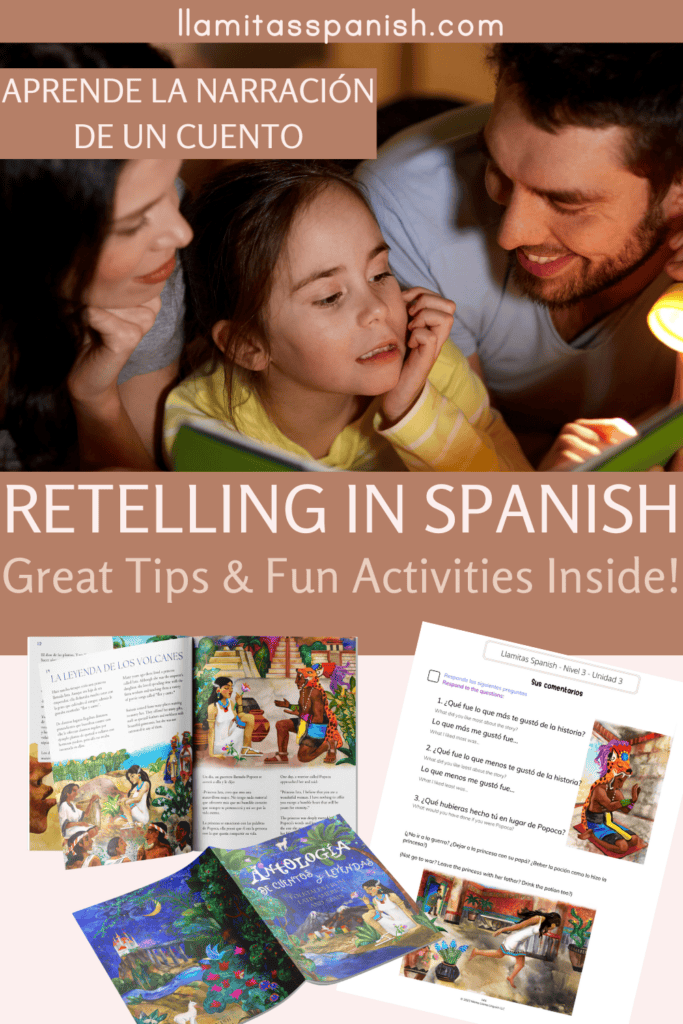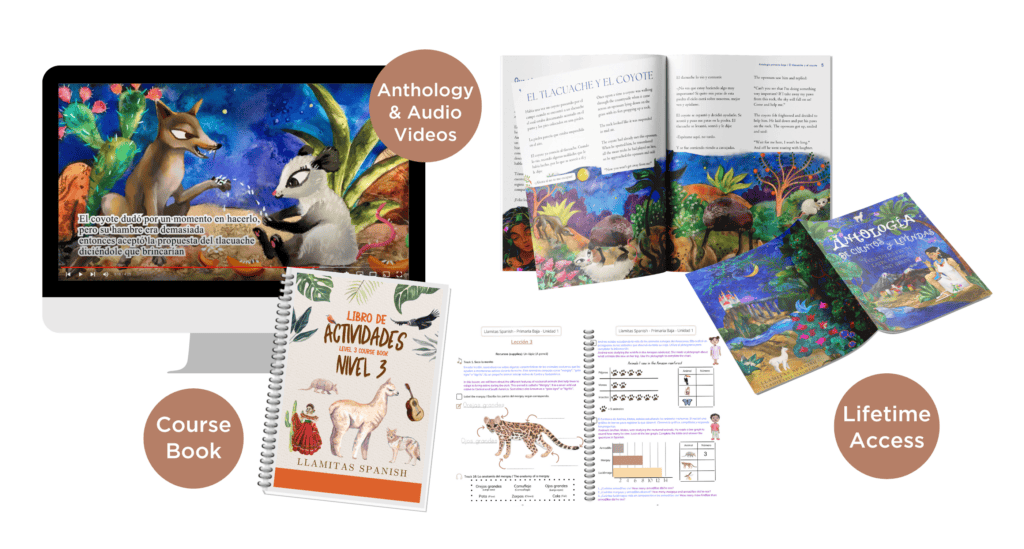In this post: Learn how to use narration in Spanish language arts to help support your child’s biliteracy skills. Discover tips and techiniques inside for Elementary Spanish.
Anyone who has learned a second language will likely tell you that, at least in the beginning, understanding a new language is far easier than actually speaking it yourself.
At that stage, you might be able to pick up on enough vocabulary to get by while listening, but stringing together a sentence on your own can be challenging.
This is why narration can be such an effective tool for language development. Practicing this skill will go a long way in supporting your child’s literacy in Spanish and working toward fluency.
At Llamitas Spanish®, we develop narration in our elementary curriculum levels. Keep reading to learn how to use narration in Spanish language arts!

Table of Contents
What is Narration?
Narration is retelling something you’ve read, heard, or seen. In the Charlotte Mason method of education, this is also sometimes called “telling back” (“volver a contar”).
Do you find yourself telling your husband about the events of your day over dinner? This is an example of narration! Likewise, when you ask your kids what they did at school or how soccer practice went that day, they’ll have to use narration to answer you.
It might sound simple, but narration is a powerful tool for language learning and literacy education!
The concept of narration comes from Charlotte Mason and is important for testing a child’s reading comprehension. It’s the discipline of recounting information based on the understanding and knowledge a child has from their reading.
Narration might look like simply retelling a story, or it might involve answering questions about a story.
This essential skill takes time to develop, but you don’t want to skip working on it. One of Mason’s principles of education listed in A Philosophy of Education is that children should “tell back” or write about what they’ve read, believing that “knowledge is not assimilated until it is reproduced.”
In other words, to truly absorb new information, we need to be able to recreate it ourselves.
Related post: Libros vivos: Living Books in Spanish
Why is Narration Important in Spanish Language Arts?
Just as narration is crucial for building literacy skills, it’s equally important when acquiring a second language, with the ultimate goal of biliteracy.
But narration isn’t only for reading. At a young age, children can develop their Spanish speaking fluency through oral narration. This first step could involve telling back parts of a story you read to them, or it could mean narrating events of their day in Spanish.
As children learn to read and write in Spanish, the next step is written narration, followed by more formal composition as they become proficient writers. These steps all build off of each other to support your child’s fluency in Spanish!
At Llamitas Spanish, a core component of our elementary leveled curriculum is teaching Spanish grammar and narration through folktales and stories.
Often, textbooks or other boxed curricula provide “busy work” that is honestly quite boring for children. At Llamitas Spanish, though, we want to nurture a love for Spanish in your child. That’s why our textbooks are beautifully illustrated and highly engaging.
Our folktales and stories are followed up with fun activities to support comprehension and writing development through narration. These include sequencing, discussing and answering open-ended questions, and even drawing at times. Narration doesn’t have to be limited to writing—it can be interactive and creative!

How to Scaffold Narration for Different Ages
Narration will naturally look different depending on your child’s age and experience with Spanish. However, even very young kids or complete beginners can begin to use narration in Spanish with the right strategies!
Here are some examples of how you might scaffold narration for different ages and levels:
- Oral narration – Initially, young kids can use oral narration to talk about what they saw or heard. They can do this before they know how to read or write.
- Start small – When you first introduce the idea of narration, begin with short sections of stories. You might read just a few sentences and have your child repeat back what they can recall.
- Draw it – This is a great alternative for younger learners! Have them answer a question about the story with a picture.
- Pulling faces – Sometimes children are reluctant to speak. In that case, ask about their thoughts on characters or events from the story, and they can respond with a happy face, sad face, angry face, or surprised face.
- Use props – Puppets, stuffed animals, or pictures might help young learners to express themselves, whether they’re retelling a part of the story or answering a question about it.
- Sequencing – A great option for early readers is to write out sentences describing the events of a story for them to put in the correct order. For younger kids, use pictures instead.
- Modeling – Even older learners might need help getting started. You can help by modeling an example sentence, so all they need to do is fill in the blank.
Tips for Narration in Spanish
For the most part, using narration in Spanish is pretty straightforward, and you may have already been using it without realizing it!
For success with narration, there are a few things you’ll want to keep in mind:
- Give your child a heads-up about what you’ll be doing. Let them know to listen closely to the story. You might even pre-teach a few important vocabulary words and tell them to listen for them in the story.
- Be mindful of your child’s skill level. Again, start by reading just a few sentences of a story and asking them to retell it. Help them by modeling sentences or using other scaffolding approaches.
- Sentences do not have to be perfect, so avoid correcting. Rather, listen to their attempts to form sentences in Spanish and praise their efforts. There’s nothing worse than being over-corrected as it can shatter a child’s confidence.
- Keep questions open-ended. The point isn’t that your child remembers every detail of a story, but that they build their speaking and listening skills.
- Practice regularly! This skill can take time to develop, so the more they practice, the easier it will get.
Narration also provides a simple and effective evaluation method! It reveals what the child has processed and retained from their learning, allowing you to assess whether another reading is required, or parts of the lesson need to be reviewed.
Related post: Dual Language Homeschool Education
Homeschool Spanish Curriculum Levels
If you’re raising bilingual and biliterate children, you don’t have to do it alone! Our Llamitas Spanish open & go curriculum series makes teaching your kids Spanish at home easy and fun.

With three elementary levels available, and one more releasing in 2025, our robust curriculum series includes beautifully illustrated stories with gentle copywork and narration activities to support your child’s literacy in Spanish. You don’t even have to do any planning or prep since everything is done for you!
